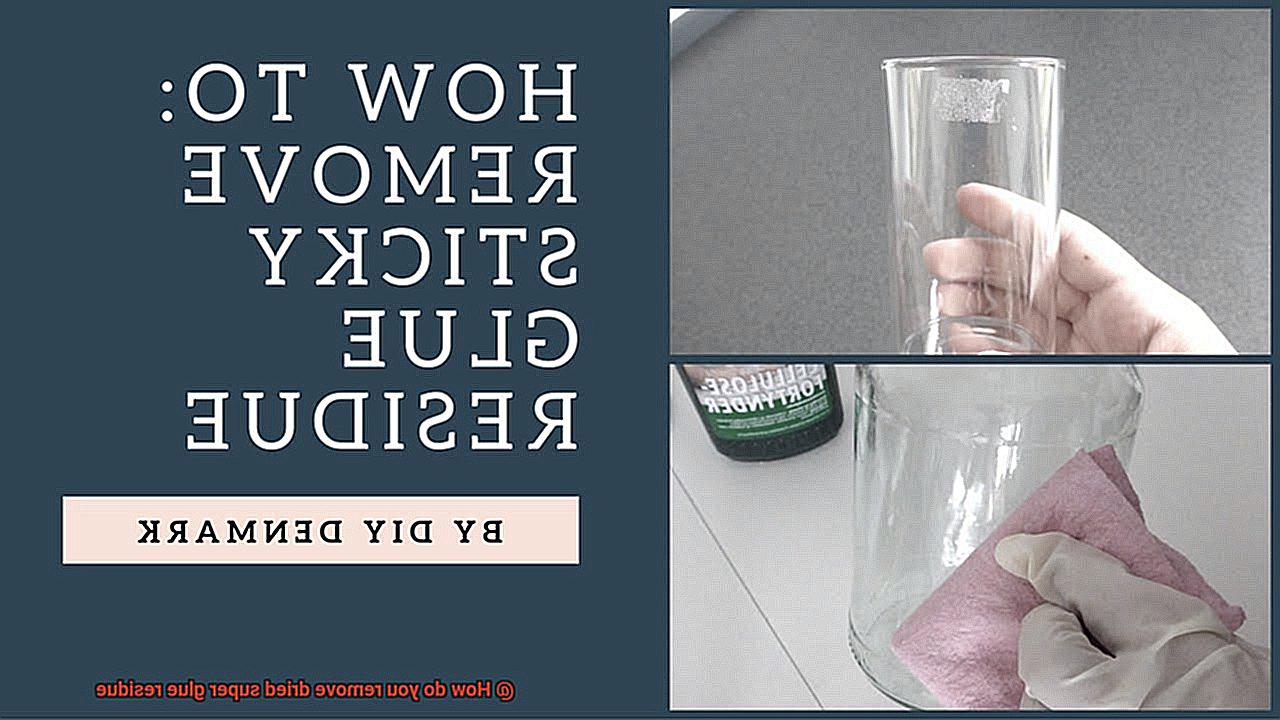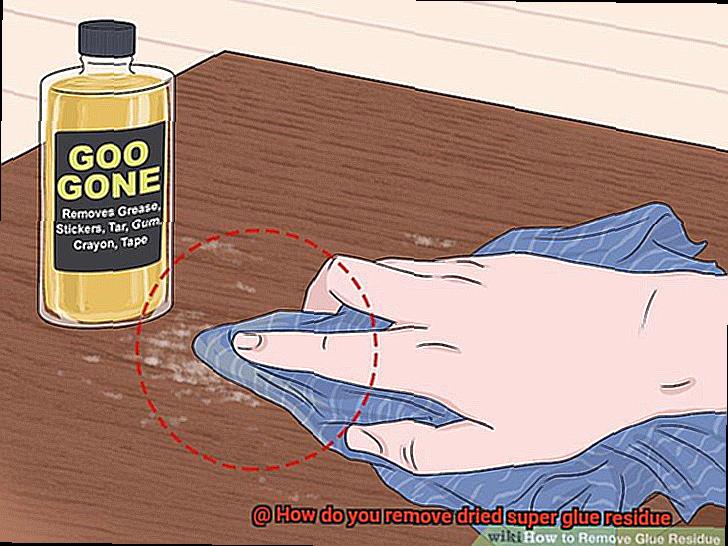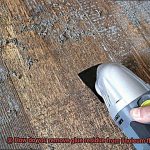Ever been ensnared by the clutches of super glue? That infuriating moment when a minuscule droplet lands on your fingertips, transforming into an impenetrable fortress within seconds. But fret not. There’s no need to surrender to this adhesive beast. We’ve got the inside scoop on banishing dried super glue residue and reclaiming control over your surfaces.
Within the confines of your home, car, or workshop, super glue has a knack for infiltrating every nook and cranny it shouldn’t. From sticky surfaces to accidental finger bonding, it’s a mess waiting to happen. But fear not, fellow warriors. We’ve compiled an all-encompassing guide that will transform you into a master of dissolving this seemingly invincible substance.
Prepare yourself for an expedition through a myriad of potent methods, each armed with its own unique prowess to obliterate super glue remnants. Unleashing the power of gentle solvents and tapping into the hidden potential of everyday household items you never knew could come to your rescue, we’ll leave no stone unturned. Oils, solvents, and heat will be our allies as we unveil their secret abilities to dissolve and soften super glue, ensuring its complete eradication without leaving behind any trace.
So buckle up, my brave companions in this sticky adventure. Get ready to unearth the secrets of removing dried super glue residue once and for all. Armed with our arsenal of knowledge, you’ll fearlessly confront any tacky predicament head-on, emerging triumphant on the other side. Bid farewell to unsightly remnants and welcome back pristine surfaces with open arms.
What Is Super Glue?
Contents
- 1 What Is Super Glue?
- 2 What Causes Super Glue to Dry?
- 3 Using Acetone to Remove Dried Super Glue Residue
- 4 Using Rubbing Alcohol or Isopropyl Alcohol to Remove Dried Super Glue Residue
- 5 Using Olive Oil or Vegetable Oil to Remove Dried Super Glue Residue
- 6 Using White Vinegar or Lemon Juice to Remove Dried Super Glue Residue
- 7 Using Heat to Remove Dried Super Glue Residue
- 8 Commercial Adhesive Removers for Removing Dried Super Glue Residues
- 9 Conclusion
Super glue, also known as cyanoacrylate adhesive, is an adhesive that possesses extraordinary bonding properties. Discovered by the brilliant Dr. Harry Coover in 1942, super glue was initially developed for military purposes, specifically to create clear plastic gun sights during World War II. However, it wasn’t until 1958 that this incredible adhesive became commercially available.
But what makes super glue so remarkable? When super glue comes into contact with moisture, whether it’s in the air or on the surfaces being bonded, a chemical reaction occurs. This reaction causes the super glue to harden rapidly, resulting in an incredibly strong bond between the surfaces.
The versatility of super glue is truly astonishing. It can bond a wide range of materials, including plastic, metal, rubber, ceramics, and even some fabrics. This makes it the go-to adhesive for repairing broken items, bonding small parts together, and embarking on exciting crafting and DIY projects.
To cater to different needs, super glue is available in various forms. Liquid super glue is the most commonly used form and is perfect for general bonding applications. Gel super glue, with its thicker consistency, is ideal for vertical applications or when you require greater control over the adhesive. Lastly, spray super glue allows for easy and even application over larger areas.
While acknowledging the tremendous power of super glue, it’s crucial to exercise caution when handling it. Super glue can unintentionally bond skin and other surfaces together. Therefore, it’s highly recommended to wear protective gloves when working with this adhesive to avoid any mishaps.
Now that we’ve explored the wonders of super glue in bonding materials together, let’s shift gears and delve into the topic of removing dried super glue residue. Inevitably, there will come a time when you need to remove dried super glue from surfaces. Luckily, there are several effective methods to tackle this challenge.
One popular approach involves using acetone, a potent solvent found in many nail polish removers. Simply apply a small amount of acetone to the dried glue and gently scrape it away. However, it’s essential to test acetone on a small, inconspicuous area first, as it can potentially damage certain surfaces.
Alternatively, rubbing alcohol or isopropyl alcohol can be utilized to break down dried super glue. Soak a cotton ball or cloth in the alcohol and gently rub the affected area until the glue starts to loosen. Remember to wash the surface with soap and water afterward to eliminate any residue.
What Causes Super Glue to Dry?
Super glue, the extraordinary adhesive that works miracles in repairs and DIY projects, has always left us in awe with its lightning-fast drying ability. But have you ever wondered what causes super glue to dry so astonishingly quick? In this captivating exploration, we will delve into the scientific wonders behind this phenomenon and shed light on the magic that makes super glue an unrivaled sticky wonder.
Polymerization: Building Bonds of Immense Strength
At the heart of super glue’s rapid drying lies a process known as polymerization. This mesmerizing chemical reaction occurs when minuscule molecules called monomers come together to form lengthy chains known as polymers. In the case of super glue, these monomers are none other than cyanoacrylate molecules.
The Catalyst of Moisture: Accelerating Bonding
When introduced to air, cyanoacrylate molecules eagerly react with the moisture present in their surroundings. This reaction acts as a catalyst, propelling the polymerization process forward and causing the monomers to swiftly intertwine. In essence, the water molecules in the air play a vital role in transforming super glue from a liquid into a solid adhesive.
Exothermic Reaction: Igniting the Drying Fire
The fusion between cyanoacrylate and water molecules ignites an exothermic reaction that releases heat as a byproduct. This intense heat further hastens the drying process, enabling super glue to bond surfaces within mere seconds. However, caution must be exercised when handling super glue to avoid contact with skin or eyes, as its exothermic nature can lead to burns or irritation.
From Liquid to Solid: The Marvelous Transformation
As the cyanoacrylate molecules undergo polymerization, they assemble into a rigid and sturdy network of polymers, transforming the liquid super glue into a solid adhesive. This awe-inspiring metamorphosis endows super glue with unparalleled strength and durability.
Viscosity: The Speed Demon Unleashed
Super glue’s low viscosity is yet another characteristic that contributes to its lightning-fast drying prowess. Viscosity refers to the thickness or resistance to flow of a liquid. With its low viscosity, super glue effortlessly spreads and swiftly comes into contact with moisture in the air, expediting the polymerization process.
Using Acetone to Remove Dried Super Glue Residue
Super glue, a beloved adhesive for its quick-drying and super-sticky properties, can leave behind a frustrating residue. But fear not. In this guide, we’ll reveal the enchanting powers of acetone in removing dried super glue residue. So grab your cotton balls and prepare to witness the captivating world of acetone.
Chapter 1: Unleash the Power of Acetone
Acetone, our hero in this battle, possesses extraordinary dissolving properties that can conquer even the most stubborn glue residues. However, beware of its strong odor and flammability. Handle it with care in a well-ventilated area away from any open flames or sparks.
Chapter 2: Test, Test, Test.
Before diving into the quest of removing that pesky residue, always conduct a small test on an inconspicuous area of the surface. This precautionary step ensures that acetone won’t unleash any unwanted damage or discoloration.
Chapter 3: Mastering the Art of Removal
Now that you’ve prepared for your mission, it’s time to take action. Start by applying a small amount of acetone onto a cotton ball or soft cloth. With gentle yet firm pressure, massage the acetone-soaked cotton ball onto the affected area, coaxing the glue residue to loosen without causing harm.
Chapter 4: Embrace Patience
Removing dried super glue residue requires a dash of patience. Allow the acetone to work its magic and dissolve the glue at its own pace. Keep rubbing until you witness those stubborn remnants surrendering under your touch.
Chapter 5: Witness the Vanishing Act
As the residue begins to yield, grab a clean cloth or paper towel to wipe away the dissolving glue. Prepare to be captivated as the remnants vanish before your eyes.
Chapter 6: Persistence Pays Off
If traces of glue residue cling on stubbornly, do not despair. Repeat the process until the surface is immaculate. Remember, persistence is the ultimate key to triumph.
Chapter 7: The Final Flourish
Having gracefully removed the super glue residue, it’s crucial to conclude with a final flourish. Wash the surface with soap and water, ensuring that every last trace of acetone is banished. Behold the spotless surface that lies before you.
Using Rubbing Alcohol or Isopropyl Alcohol to Remove Dried Super Glue Residue
I am about to reveal the secret weapon that will make your struggles disappear like magic. Brace yourselves as we delve into the remarkable world of rubbing alcohol (or isopropyl alcohol), uncovering its incredible ability to dissolve even the most obstinate remnants. So gather your tools – cotton balls and cloth – and let us embark on a captivating journey to rid ourselves of this sticky nuisance once and for all.
Obtaining the Elixir:
In our quest to conquer super glue residue, our hero comes in the form of rubbing alcohol, also known as isopropyl alcohol. This mystical potion can be found in most drugstores and supermarkets, with concentrations ranging from 70% to 91%. While both concentrations are effective, the higher concentration may yield superior results.
The Crucial Test:
Before immersing ourselves in battle, it is essential to perform a small test on an inconspicuous area of the surface. This precautionary measure ensures that our chosen elixir does not inflict any damage or discoloration. Remember, it is better to be safe than sorry.
Unleashing the Magic:
To banish super glue residue using rubbing alcohol, arm yourself with cotton balls or a soft cloth. Immerse them generously in the elixir and gently dab or rub the affected area. Employ slight pressure to loosen the adhesive’s grip, but exercise caution to avoid harm.
The Virtue of Patience:
Now, dear warriors, is when we must summon our patience. The alchemical powers of rubbing alcohol may require time and repeated applications to fully dissolve the dried glue. Refrain from aggressive scrubbing that could mar the surface; instead, embrace the virtue of patience and observe as the residue surrenders to your touch.
A Vanishing Act:
As the remnants of super glue vanish before your eyes, wipe away any residual alcohol with a clean cloth or sponge. To ensure an immaculate surface, rinse the area with mild soap and water, eliminating any traces of the rubbing alcohol.
Using Olive Oil or Vegetable Oil to Remove Dried Super Glue Residue
I am here to share with you the mystical powers of olive oil and vegetable oil in the fight against this sticky nuisance.
Olive oil and vegetable oil, the unsung heroes of your kitchen cabinet, hold the key to banishing dried super glue residue. These household items possess the extraordinary ability to break down the adhesive properties of the glue, making it easier to remove. So, let’s delve into the process of harnessing the power of these oils to bid farewell to that pesky residue once and for all.
First things first, reach for that trusty bottle of olive oil or vegetable oil. Begin by applying a small amount directly onto the affected area. Be generous but not excessive – we’re aiming to coax the glue into submission, not drown it.
Once you’ve applied the oil, summon your patience and let it perform its magic. Allow the oil to permeate and weaken the stubborn adhesive for a few minutes. Remember, patience is a virtue when dealing with tenacious glue.
After giving the oil sufficient time to work its wonders, it’s time to take action. Armed with a soft cloth or sponge, gently massage the area in circular motions. As you do so, witness the satisfying sight of the glue residue relinquishing its grip and surrendering under your touch. Victory is within reach.
If, by some chance, traces of glue still cling on defiantly, fear not. Simply add a bit more oil and persist in your efforts until every last bit of residue is vanquished. Remember, persistence pays dividends in this battle.
Once you have successfully eradicated all signs of glue, it’s time for the final step – bidding adieu to any lingering oil. Grab some warm soapy water and scrub away any remnants. This meticulous cleanse ensures that your surface is left squeaky clean and ready for its next adventure.
Using White Vinegar or Lemon Juice to Remove Dried Super Glue Residue
In the realm of sticky mishaps, few challenges are as frustrating as dealing with dried super glue residue. But fear not, my fellow adhesive adventurers. I bring you tidings of triumph from the realms of household magic: white vinegar and lemon juice. These unsung heroes of the kitchen possess hidden powers that can break down the bonds of super glue, liberating you from the clutches of stubborn remnants. So, don your apron and let us embark on a journey into the world of vinegar and lemon juice, our trusted allies in the battle against tenacious super glue residue.
The Vinegar Victory:
Harnessing the acidic prowess of white vinegar, we can emerge victorious over dried super glue residue. Behold the steps to triumph:
- Immerse a cloth or cotton ball in the potent elixir that is white vinegar.
- Lay the soaked cloth onto the affected area and allow it to work its magic for a few moments.
- Witness as the vinegar gradually softens the glue’s grip, rendering it more pliable for removal.
- Employ a plastic scraper or your nimble fingernail to gently scrape off the softened glue.
- Exercise caution and patience, ensuring no harm befalls the underlying surface.

The Lemon Juice Legend:
Enter lemon juice, bearer of natural acidity and another formidable weapon against dried super glue residue. Unleash its full potential with these mighty steps:
- Extract fresh lemon juice and anoint a cloth or cotton ball with its zesty power.
- Bestow upon the dried super glue residue this citrus-infused offering.
- Grant time for the acid within the lemon juice to penetrate and weaken the adhesive bonds.
- Engage in the exhilarating act of scraping off the softened glue using a plastic scraper or your dexterous fingernail.
- Maintain a gentle touch, for the preservation of the surface beneath is paramount.
Using Heat to Remove Dried Super Glue Residue
This method is not only effective but also easily accessible with a simple household item – your trusty hairdryer. Just imagine, that hair styling companion can now be your savior in the battle against stubborn adhesive remnants.
To unleash the power of heat, set your hairdryer to a medium or high heat setting and hold it about 6 inches away from the glued surface. Feel the warmth as you move the dryer back and forth over the glue for 30 seconds to a minute. The heat softens the glue, making it much easier to remove.
But remember, as with any weapon, caution is necessary. Avoid holding the dryer too close or using excessive heat, as this can cause damage or unsightly discoloration on your beloved materials. Moderation is key when harnessing the power of heat.
Now that you’ve heated things up, it’s time to tackle the residue removal process. After heating the glue, gently peel or scrape off the softened residue using a soft cloth or plastic scraper. Be careful not to scratch or damage the surface – we want a clean victory without any casualties.
In some cases, heat alone may not completely eliminate all traces of super glue. If there are still remnants left, fear not. We have reinforcements in the form of acetone or rubbing alcohol to finish off any remaining resistance from the super glue army.
But before you embark on your heat-powered mission, remember to work in a well-ventilated area. The fumes released by heat and chemicals can be potent, so crack open a window and let the fresh air in while you work your magic.
Safety is paramount in any battle, so don’t forget to gear up before you go into combat. Protect yourself by wearing gloves and eye goggles to shield from potential harm. Victory is sweet, but not at the expense of our own well-being.
While heat is particularly effective on surfaces like glass, metal, and ceramic, caution should be exercised with delicate materials. Plastic and fabric, for example, may melt or get damaged when exposed to heat. Always test a small inconspicuous area before applying heat to ensure no adverse effects on the material.
Commercial Adhesive Removers for Removing Dried Super Glue Residues
I have the inside scoop on the best commercial adhesive removers to save the day. These magical potions are specially formulated to tackle even the toughest super glue residues, making your cleaning endeavors a breeze. Let’s dive right in and explore the different types of commercial adhesive removers available and how to use them effectively.
First on our list is the mighty acetone. This superhero is not only a key ingredient in nail polish removers but also a master at breaking down super glue. Just apply a generous amount of acetone directly onto the dried residue and let it work its magic for a few minutes. Watch as it penetrates and softens the glue, allowing you to easily scrape it off with a plastic scraper or old credit card. Remember, no metal tools allowed to prevent scratches or damage. Safety first, superheroes.
If you prefer a gentler alternative, turn to rubbing alcohol, your trusty sidekick. It’s less harsh than acetone and can be used on a wider range of surfaces without causing any damage. Simply soak a cotton ball or cloth in rubbing alcohol and apply it directly to the dried super glue residue. Let it sit for a few minutes to work its magic, and then gently wipe or scrape off the softened glue. Easy peasy, right?
But wait, there’s more. Some adhesive removers are specifically formulated for removing super glue residues. These wonder products can be found at hardware stores or online retailers in spray or liquid form. Follow the manufacturer’s instructions when using these specialized removers, as they may require specific application techniques or safety precautions. Safety goggles and capes are optional but highly recommended.
Once you’ve successfully removed the dried super glue residue using a commercial adhesive remover, it’s time to give your surface some tender loving care. Clean it with soap and water to remove any remaining residue from the remover itself. This final step ensures a squeaky-clean finish, leaving your surfaces looking as good as new.
Before embarking on your super glue removal journey, always remember to test any commercial adhesive remover on a small inconspicuous area. This precautionary step will guarantee that the remover doesn’t cause any damage or discoloration to your beloved surfaces. Better safe than sorry, right?
MH5vzytZa3w” >
Conclusion
Removing dried super glue residue can be a frustrating task, but fear not.
There are several effective methods you can try to tackle this sticky situation. One option is to use acetone, a powerful solvent that breaks down the adhesive properties of super glue.
Simply soak a cotton ball or cloth in acetone and gently rub it onto the affected area until the residue starts to dissolve. Another alternative is using nail polish remover, which contains acetone as well.
Just make sure to choose one that is acetone-based for optimal results. If you don’t have any acetone on hand, don’t worry.
You can also try using rubbing alcohol or vinegar as a substitute. Apply either of these liquids onto a cloth and gently scrub the residue until it loosens up.
For tougher stains, you may need to repeat the process multiple times. Remember to always test these solutions on a small, inconspicuous area first to avoid damaging the surface you’re working on.
Once you’ve successfully removed the dried super glue residue, clean the area with soap and water to ensure no traces are left behind.






